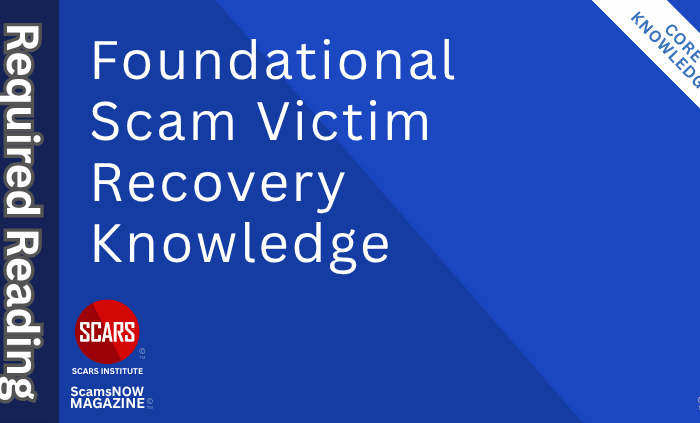
The Art of Deception and Scammer Storytelling
The Art of Deception and Masterful Storytelling: How Scammers Tell Stories to Entrap Victims in Relationship Scams
Primary Category: Psychology of Scams
Author:
• Vianey Gonzalez B.Sc(Psych) – Licensed Psychologist, Specialty in Crime Victim Trauma Therapy, Neuropsychologist, Certified Deception Professional, Psychology Advisory Panel & Director of the Society of Citizens Against Relationship Scams Inc.
• Tim McGuinness, Ph.D., DFin, MCPO, MAnth – Anthropologist, Scientist, Polymath, Director of the Society of Citizens Against Relationship Scams Inc.
Author Biographies Below
About This Article
Scammers exploit the psychology and neuroscience of storytelling to engineer persuasive relationship and investment scams. Narratives organize meaning, shape identity, and bond listeners, while activating brain networks tied to imagination, planning, empathy, reward, and memory. Jordan Peterson’s emphasis on myth and archetypes details tactics including love bombing, fabricated crises, social proof, and rapid intimacy, as well as pig butchering schemes that use fake platforms, staged profits, and secrecy. Concepts such as narrative transport, suspension of disbelief, and cognitive biases show some of the reasons why victims overlook red flags. Storytelling’s role in trauma processing and recovery is vital, urging critical evaluation of emotionally charged narratives to counter manipulation and reduce revictimization.
Note: This article is intended for informational purposes and does not replace professional medical advice. If you are experiencing distress, please consult a qualified mental health professional.

The Art of Deception and Masterful Storytelling: How Scammers Tell Stories to Entrap Victims in Relationship Scams
In human interaction, few things are as captivating as a well-told story. Stories have the power to move us, to make us feel, and to shape our perceptions of the world. This is a truth that Jordan Peterson often explores in his work, highlighting how narratives are not just entertainment but fundamental to our understanding of reality. It’s this very power of storytelling that makes relationship scams so effective. By crafting compelling narratives, scammers tap into the deepest parts of our psyche, making us susceptible to their deceptions.
The Psychology of Storytelling
Storytelling is one of the brain’s primary ways of processing reality. Psychologically, it serves several key functions at once. It helps create meaning by turning scattered events into structured sequences with causes and consequences, which answer questions like “What does this mean?” and “What should I learn from this?” It supports identity by shaping both personal stories (“I am the kind of person who…”) and group stories (“In our family / culture / community, we believe…”). It strengthens social connection, because when one person tells a story and another listens, they are not just exchanging information, they are sharing emotions, values, and worldviews. Storytelling also helps regulate emotion, especially around painful events, by giving feelings a beginning, middle, and end rather than leaving them as chaotic fragments. This is part of why it improves memory and learning: a single narrative can bundle facts, emotions, warnings, and social rules into one mental package that is easier to remember and reuse later.
Neurologically, there is no single “story center” in the brain. Storytelling activates a whole network, including the default mode network (involved in daydreaming, remembering the past, and imagining the future), the prefrontal cortex (planning, moral judgement, cause and effect), and temporal and language areas (words and meaning). Stories also engage mirror systems that simulate what others feel, which supports empathy. When someone hears about danger, shame, love, or relief, the brain can partially “mirror” those states internally. The reward system is involved as well: suspense and curiosity in stories are linked to dopamine, which supports motivation and learning, and satisfying resolutions reinforce the patterns and lessons being told. Emotional stories activate the limbic system, including the amygdala and hippocampus, which helps mark certain moments as important and more likely to be stored in long-term memory.
In trauma, including scam victimization, storytelling plays a specific role. Traumatic experiences often begin as fragments: flashes of images, bodily sensations, and raw feelings rather than a clear narrative. Constructing a coherent story recruits higher brain regions and language systems to organize what happened, label emotions, and place events in time. This helps shift a person from being trapped “inside” the event to becoming a narrator and witness to it. Carefully retelling a painful story in safe contexts can gradually reduce its intensity, as the brain learns that remembering is not the same as reliving. This is a core element of many trauma-focused therapies, where structured storytelling is combined with grounding and support.
Cognitively, storytelling supports several important functions. It strengthens the theory of mind, the ability to understand that others have their own thoughts, beliefs, and feelings, by constantly asking the brain to track what different characters know and intend. It supports moral reasoning by exploring who was harmed, who is responsible, and what repair is possible. It assists future simulations by allowing people to mentally test different choices and their consequences before acting in real life. After a major disruption, it provides a framework for sense-making by helping answer “Who am I now?” and “What does this mean for my life?” This is particularly important when trust, identity, or belonging have been shaken.
People are especially drawn to stories rather than plain facts for several reasons. Storytelling can synchronize brain activity between speaker and listener, creating shared focus and emotional flow. Narratives compress complexity into something understandable, reducing mental load. They bind emotion and information together, which makes lessons “stickier” in memory. They also feel safer than direct instruction, since a story can say “Here is what happened to someone” instead of “Here is what you must do,” which lowers defensiveness and shame.
The same mechanisms that make storytelling powerful for healing also make it a tool for manipulation. Scammers, politicians, and other exploiters often build persuasive narratives of connection, expertise, or shared fate. They present themselves as caring partners, protectors, or guides, and offer a story in which the victim is special, chosen, or finally understood. The brain responds to these stories using the same systems that respond to genuine connection, which is a reflection of normal human wiring, not personal weakness.
Recovery often involves building a new story that includes the crime and the harm, but does not allow it to become the whole identity.
Taken together, psychology and neuroscience see storytelling as a natural way for the brain to encode, store, and communicate experience, a bridge between emotion and logic, a path for both vulnerability and healing, and a central tool in shaping who a person becomes after both injury and growth.
Humans as Storytellers
Humans are inherently storytellers, a trait that has been woven into the fabric of our existence since time immemorial. From the earliest cave paintings that depicted ancient hunts and mythical creatures to the latest blockbuster films that captivate global audiences, stories have been our constant companions. They are more than mere entertainment; they are the lenses through which we view and make sense of the world. Stories provide us with structure, meaning, and emotional resonance, acting as guiding lights in the often chaotic landscape of life.
Jordan Peterson often emphasizes the profound importance of myths and stories in shaping human understanding and behavior. He argues that these narratives are not just fanciful tales but are deeply rooted in the human psyche, offering us a framework for navigating the complexities of existence. Stories, in Peterson’s view, are essential roadmaps that help us deal with the inherent chaos of life. They provide us with archetypes, symbols, and lessons that resonate across cultures and generations, offering insights into the nature of reality and our place within it.
The power of storytelling is undeniable, and it is this power that scammers exploit in relationship scams, whether about romance, investment, or something else. Scammers are modern-day bards, skilled in the art of weaving tales that are as enticing as they are deceptive. They understand that a well-crafted story can bypass our rational minds and speak directly to our emotions, tapping into our deepest desires, fears, and aspirations. This emotional resonance is what makes their narratives so compelling and, ultimately, so dangerous.
Consider the psychological underpinnings of why stories are so effective. Stories engage multiple parts of the brain, including those responsible for language, emotion, and visual processing. When we hear a story, our brains release neurotransmitters like oxytocin, which is associated with trust and empathy. This chemical response makes us more receptive to the narrative and more likely to suspend our disbelief. Scammers leverage this biological response, crafting stories that evoke strong emotional reactions, making their targets more vulnerable to manipulation.
Furthermore, stories provide a sense of order and predictability in an often unpredictable world. They offer us a way to make sense of complex situations and to anticipate future events. Scammers exploit this by creating narratives that seem to offer clarity and direction, even when the reality is far from straightforward.
For example, a scammer might present a story of a struggling single parent, tapping into the victim’s empathy and desire to help. The narrative provides a clear path for the victim to follow, making them feel as though they are making a meaningful difference in someone’s life.
The effectiveness of storytelling in scams is also enhanced by the way it taps into our collective unconscious. Peterson often discusses the concept of archetypes and how they shape our perceptions and behaviors. Scammers are adept at incorporating these archetypes into their narratives, making their stories more relatable and resonant. For instance, the “prince charming” archetype plays on the deeply ingrained desire for a fairy-tale romance, while the “damsel in distress” narrative taps into our hero complex, making us want to save the day.
Also, stories have the power to create a shared reality between the teller and the listener. When a scammer shares their narrative, they are not just relaying information; they are inviting the victim to participate in a shared experience. This shared reality can be so immersive that it becomes difficult for the victim to distinguish between the story and their actual life. The scammer’s narrative becomes the victim’s truth, making it harder for them to see the deception for what it is.
The psychology of storytelling also involves the concept of narrative transport, where individuals become so engrossed in a story that they lose track of their surroundings and their own reality. Scammers exploit this by creating narratives that are so engaging and emotionally charged that victims become transported into the story, losing sight of the red flags and inconsistencies. This transport is a powerful tool for manipulation, as it allows the scammer to guide the victim’s thoughts and actions without them realizing it.
The psychology of storytelling is a powerful force that scammers exploit to great effect in relationship scams. By understanding the innate human love for stories and the emotional resonance they evoke, scammers can craft narratives that bypass rational thought and speak directly to the heart. This understanding highlights the importance of being aware of the stories we encounter and critically evaluating them, even when they seem too good to be true. By doing so, we can better protect ourselves from falling prey to these deceptive tales and navigate the complexities of life with greater clarity and discernment.
Relationship Scams as Narrative Constructs
Scammers are indeed masters of narrative construction, meticulously crafting stories that are tailor-made to appeal to their targets. These narratives are not random or haphazard; they are carefully designed to exploit universal human themes and desires, such as love, trust, and security. By tapping into these deeply ingrained aspirations, scammers create a powerful emotional pull that makes their targets more susceptible to deception.
One of the most common and effective narrative constructs is the “Prince Charming” archetype. In this scenario, the scammer presents themselves as the perfect partner, someone who is not only attractive and charming but also seemingly devoted to the victim. They sweep the victim off their feet with grand gestures and promises of a future filled with love and happiness. This narrative plays on the deeply ingrained desire for a fairy-tale romance, a trope that has been perpetuated through countless stories, movies, and cultural narratives. The allure of finding “The One” who will fulfill all your dreams and desires is so strong that it can blind the victim to the red flags and inconsistencies in the scammer’s story.
For example, the scammer might promise a lavish lifestyle, complete with exotic vacations, luxurious gifts, and a future of endless bliss. They might even go so far as to send the victim expensive presents or plan elaborate dates, all to reinforce the narrative of a perfect, fairy-tale romance. The victim, caught up in the whirlwind of emotion and the promise of a dream come true, is more likely to overlook the scammer’s reluctance to meet in person, their vague responses to personal questions, or the sudden requests for money. The narrative is so compelling that it becomes the victim’s reality, making it difficult for them to see the deception for what it is.
Another popular and equally effective narrative is the “Damsel in Distress.” In this construct, the scammer presents themselves as someone in need of help, often with a tragic backstory or a dire situation. This narrative taps into the victim’s empathy and their desire to be a hero, someone who can save the day and make a difference in another person’s life. The scammer might claim to be a struggling single parent, a victim of a natural disaster, or someone facing a medical emergency. They weave a tale of woe and desperation, making the victim feel a deep sense of compassion and a strong urge to help.
The power of this narrative lies in its ability to make the victim feel needed and important. By positioning themselves as a helpless victim, the scammer can manipulate the victim’s emotions, making them more likely to overlook inconsistencies and logical flaws in the story. For instance, the scammer might claim to need money for an urgent medical procedure or to support their struggling family. The victim, driven by empathy and a desire to help, will often send money without questioning the details or the scammer’s true intentions.
Moreover, scammers often combine multiple narrative elements to create a more complex and convincing tapestry of deceit. They might start with the “Damsel in Distress” narrative, appealing to the victim’s empathy, and then gradually introduce elements of the “Prince Charming” archetype, promising a future together once the initial crisis is resolved. This layered approach makes the narrative more resilient to scrutiny, as each layer reinforces the overall story and makes it harder for the victim to see the deception.
The effectiveness of these narrative constructs lies in their ability to tap into the victim’s deepest desires and vulnerabilities. Scammers are adept at identifying these emotional hotspots and crafting stories that resonate with their targets on a profound level. Whether it’s the promise of a fairy-tale romance or the opportunity to be a hero, these narratives create a powerful emotional pull that can override rational thought and critical judgment.
Plus, scammers often use cultural and societal narratives to their advantage. They might draw on popular media, such as romantic movies or bestselling novels, to create a sense of familiarity and relatability in their stories. By mirroring these well-known narratives, scammers can make their own stories seem more plausible and appealing to their victims. For example, a scammer might model their “prince charming” persona after a popular leading man in a romantic film, complete with similar mannerisms, dialogue, and promises of a happy ending.
The skillful weaving of these narrative elements creates a tapestry of deceit that is both beautiful and dangerous. It is beautiful in the sense that it appeals to the victim’s deepest desires and dreams, offering them a vision of a perfect life or a chance to make a meaningful difference. However, it is dangerous because it blinds the victim to the reality of the situation, making them vulnerable to exploitation and manipulation.
Relationship scams as narrative constructs are a testament to the power of storytelling in human psychology. Scammers exploit universal themes and desires, such as love, trust, and the desire to help others, to create compelling narratives that resonate with their targets. By tapping into these deeply ingrained aspirations, scammers can bypass rational thought and manipulate their victims on an emotional level. Understanding the structure and power of these narrative constructs can help individuals better protect themselves from falling prey to these deceptive tales.
Emotional Manipulation Through Storytelling
The power of these narratives lies in their ability to manipulate emotions, a tactic that is both subtle and incredibly effective, which is why Hollywood does it. Scammers are also adept at using storytelling to build trust and create a deep emotional attachment between the victim and the fabricated persona. This emotional investment is the linchpin of the scam, transforming what might otherwise be a fleeting interaction into a deeply personal and meaningful connection. Once the victim is emotionally entangled, their ability to critically evaluate the situation diminishes, and they become more susceptible to the scammer’s manipulations.
Dr. Peterson often emphasizes the profound role of emotion in shaping behavior and decision-making. He argues that our emotions are not merely responses to external stimuli but are fundamental to how we perceive and interact with the world. This emotional landscape is where scammers operate most effectively. By crafting narratives that resonate with the victim’s deepest desires, needs or fears, scammers can bypass the rational mind and tap directly into the emotional core. This is why victims often find themselves acting against their better judgment, driven by the powerful emotions that the story has evoked.
Consider the emotional hooks that scammers often use: the promise of a fairy-tale romance, the allure of a glamorous lifestyle, or the satisfaction of being a hero to someone in need. These themes are universal and deeply ingrained in human psychology. Scammers exploit these universal desires by creating narratives that are tailor-made to appeal to the victim’s emotional vulnerabilities.
The emotional manipulation in these scams is often gradual, beginning during the luring and grooming phases, allowing the victim to become increasingly invested over time. Initially, the scammer might share a small, seemingly harmless story that evokes sympathy or excitement. As the victim becomes more emotionally engaged, the scammer introduces more complex and emotionally charged narratives, gradually building a web of deception. This incremental approach ensures that the victim is fully invested before the scam reaches its climax, making it harder for them to extricate themselves.
Jordan Peterson’s insights into the role of emotion in human behavior provide a lens through which to understand the effectiveness of these scams. He argues that our emotions are not just reactions to events but are integral to how we navigate the world. They provide us with a framework for understanding and responding to our environment. Scammers exploit this by creating emotional narratives that bypass rational thought, making the victim more likely to accept the story at face value. The victim becomes so caught up in the story that they lose sight of reality, making them vulnerable to exploitation.
Additionally, the emotional manipulation in these scams often involves the creation of a false sense of intimacy and connection. Scammers are skilled at mimicking the behaviors and language of genuine emotional attachment, making the victim feel as though they are in a real, meaningful relationship. This false intimacy is a powerful tool for manipulation, as it makes the victim more likely to overlook inconsistencies and continue to engage with the scammer, even as the story becomes increasingly implausible.
The emotional investment also creates a sense of loyalty and commitment in the victim, making them less likely to question the scammer’s actions or motivations. They may feel a strong desire to support and protect their “partner,” even when it comes at a significant personal cost. This emotional entanglement can be so profound that victims may continue to support the scammer long after the initial deception has been revealed, driven by a misguided sense of loyalty and attachment.
The emotional narratives used in these scams often tap into the victim’s sense of self-worth and identity. By making the victim feel special, desired, or needed, scammers can create a powerful emotional bond. This sense of validation and importance can be intoxicating, making the victim more susceptible to the scammer’s manipulations. They may begin to see themselves through the lens of the story, further blurring the lines between reality and fiction.
Remember, that in a real, authentic new relationship, it is never idyllic; there is a procession of small conflicts and misunderstandings as each person learns the other person. Constantly being presented with stories is not how to build a lasting bond.
Dr. Peterson often speaks of the importance of self-awareness and the need to question the narratives we encounter. He argues that by being mindful of our emotional responses and the stories we tell ourselves, we can better navigate the complexities of life. In the context of relationship scams, this means being aware of the emotional hooks being used and critically evaluating the narratives being presented. By doing so, one can better protect oneself from falling prey to these deceptive tales.
This emotional manipulation through storytelling is a powerful and effective tool used by scammers to deceive and exploit their victims. By tapping into the deepest parts of our psyche, scammers create narratives that bypass rational thought and speak directly to our emotions. This emotional investment makes victims more susceptible to deception, as they become emotionally entangled and less able to critically evaluate the situation. Understanding this can help in preventing or identifying such scams now and in the future, highlighting the importance of emotional awareness and critical thinking in protecting oneself from these deceptive tales.
The Role of Suspension of Disbelief
One of the most powerful tools in a scammer’s storytelling arsenal is the ability to make the victim suspend their disbelief. This concept, borrowed from literature and film, involves audiences willingly (though they are not even aware they are doing it) setting aside their skepticism to fully immerse themselves in a story. In the context of relationship scams, this means the victim is willing to overlook inconsistencies and logical flaws in the scammer’s narrative, choosing instead to believe the story being presented. This is both a manipulative tactic and also an inherent vulnerability that almost all humans have.
Dr. Peterson emphasizes the critical role of belief and meaning in human life, arguing that stories are essential for making sense of the world and providing a framework for our actions. This is why suspension of disbelief is so effective in scams. The victim isn’t merely believing a story; they are embracing a version of reality crafted by the scammer. This belief becomes a powerful motivator, compelling the victim to act in ways they might not otherwise consider, even against their own well-being.
For instance, consider “Alex,” who was targeted by a scammer posing as a successful entrepreneur. The scammer’s narrative was so compelling that Alex suspended their disbelief, ignoring or not seeing the red flags, like the scammer’s reluctance to meet in person. The story became Alex’s reality, leading them to make financial decisions that benefited the scammer. This example highlights how suspension of disbelief can blind individuals to the truth, making them vulnerable to exploitation.
In another case, “Jamie” was drawn into a scam involving a supposed foreign prince in need of financial assistance. Jamie’s suspension of disbelief was fueled by the romantic and adventurous aspects of the story. Despite the obvious inconsistencies, Jamie continued to support the scammer, believing in the narrative even as it became increasingly implausible. This illustrates how the power of storytelling can override rational thought, making victims susceptible to deception.
How Humans See and Experience the World Through Stories
Stories are not just a form of entertainment; they are the very lens through which humans perceive and interpret the world. From the moment we are born, we are immersed in narratives that shape our understanding of reality, and in fact, even shape our very brains. Whether it’s the fairy tales we hear as children or the news headlines we read as adults, stories provide us with a framework for making sense of the complex and often chaotic world around us.
Professionals, such as Dr. Jordan B. Peterson and Joseph Campbell, often emphasize the importance of myths and stories in providing a sense of order and meaning. They argue that these narratives are not mere fantasies but are deeply rooted in the human psyche, offering us insights into the nature of existence and our place within it. Stories help us to navigate the unknown, to make sense of the past, and to envision the future. They are the tools we use to understand ourselves and others, to define our values, and to find our purpose.
In the context of relationship scams, this inherent human reliance on stories becomes both a strength and a vulnerability. Scammers exploit this by creating narratives that are so compelling and relatable that they bypass our rational faculties. They tap into our deepest desires, fears, and aspirations, weaving a tale that resonates with our innermost selves. This is why these scams are so effective; they speak to the very core of who we are as storytelling beings.
Consider the story of “Emily,” a woman who was targeted by a scammer posing as a successful businessman. The scammer crafted a narrative of a busy, traveling executive who was looking for a genuine connection. Emily, drawn to the idea of a romantic partner who was both successful and emotionally available, became deeply invested in the story. She ignored the warning signs, such as the scammer’s inability to meet in person, because the narrative was so compelling and aligned with her desires.
Similarly, “David,” a man who fell for a scammer posing as a single mother, was moved by the narrative of a struggling parent trying to provide for their child. David’s empathy and desire to be a hero were exploited by the scammer, who skillfully wove a tale that tapped into his deepest emotions. The story became a reality for David, and he continued to support the scammer financially, believing in the narrative even as it unraveled.
These examples illustrate how stories shape our perceptions and experiences. They show how easily we can be drawn into a narrative that resonates with our emotions and desires, even when it is a deception. This is a powerful reminder of the importance of critical thinking and the need to question the stories we encounter.
Dr. Peterson often speaks of the need to be aware of the narratives we tell ourselves and others. He argues that by understanding the stories we live by, we can better navigate the complexities of life. In the context of relationship scams, this means being mindful of the narratives being presented and critically evaluating them. By doing so, one can better protect oneself from falling prey to these deceptive tales.
Why Storytelling Makes Scams Effective
The effectiveness of relationship scams lies in their ability to tap into the deepest parts of our psyche. By crafting compelling narratives, scammers create a world that is both alluring and deceptive. This is why these scams are so hard to detect and why so many people fall victim to them. The story becomes a reality that the victim is willing to believe in, even as it unravels around them.
Jordan Peterson often speaks of the importance of critical thinking and the need to question the narratives we encounter. He argues that by being aware of the stories we tell ourselves and others, we can better navigate the complexities of life. In the context of relationship scams, this means being mindful of the narratives being presented and critically evaluating them. By doing so, one can better protect oneself from falling prey to these deceptive tales.
Essential Story Elements Employed by Romance Scammers
Scammers are adept at crafting narratives that resonate with their romance scam targets, employing a variety of storytelling components to assemble their deceptive tales.
Here is a set of the key storytelling elements that romance scammers use to construct their narratives:
- Emotional Hooks: Scammers often start with a strong emotional hook, such as a tragic backstory or a promise of a fairy-tale romance. This immediate emotional connection helps to draw the victim in and make them more susceptible to the narrative.
- Consistent Communication: Scammers maintain frequent and consistent communication to build a sense of familiarity and trust. This can involve daily messages, video calls, or even fake voice notes to make the interaction seem more real.
- Fake Profiles and Identities: Scammers create detailed fake profiles, often using stolen photos or AI-generated images, to make their personas seem authentic. These profiles are designed to appeal to the victim’s interests and desires.
- Love Bombing: This tactic involves overwhelming the victim with excessive displays of affection and attention to create a strong emotional bond quickly. Scammers use compliments, gifts, and declarations of love to make the victim feel special and wanted.
- Fabricated Emergencies: Once trust is established, scammers introduce fabricated emergencies, such as medical crises, legal issues, or financial troubles, to create a sense of urgency and push the victim into making hasty decisions.
- Request for Money or Gifts: Scammers gradually introduce requests for money or expensive gifts, often framing these requests as necessary to resolve the fabricated emergencies or to further the relationship.
- Isolation Tactics: Scammers may encourage victims to isolate themselves from friends and family, claiming that these relationships are a threat to their newfound love. This isolation makes the victim more dependent on the scammer.
- Manipulation of Emotions: Scammers skillfully manipulate the victim’s emotions, alternating between affection, aloofness, and anger to keep them off balance and more compliant. This emotional rollercoaster makes it harder for the victim to think clearly.
- Use of Technology: Scammers leverage technology, such as AI and deepfakes, to create convincing video calls or messages. They may also use generative AI tools to create fake vacation rental properties or other deceptive content to support their narrative.
- Shared Experiences and Memories: Scammers create a sense of shared history by inventing past experiences and memories, making the relationship feel more genuine and long-standing.
- Promises of a Future Together: Scammers often promise a future filled with love, adventure, and happiness, tapping into the victim’s deepest desires and aspirations. This promise of a dream life together is a powerful motivator.
- Exploitation of Vulnerabilities: Scammers target individuals who are emotionally vulnerable, such as those who are lonely, recently divorced, or grieving. They exploit these vulnerabilities to make their narratives more compelling.
- Social Engineering: Scammers use social engineering tactics to manipulate and influence people, gaining their trust and exploiting their emotions. This often involves mimicking the behaviors of genuine romantic partners.
- Quick Escalation of the Relationship: Scammers move the relationship forward at an unusually fast pace, creating a sense of intensity and urgency. This quick escalation can make the victim feel like they are in a whirlwind romance, blinding them to potential red flags.
- Request for Personal Information: Scammers ask for personal information, such as addresses, phone numbers, and financial details, to build a more detailed and convincing narrative. They may also request access to the victim’s social media accounts to gather more information.
These storytelling components are carefully woven together to create a tapestry of deceit that is both compelling and dangerous. By understanding these elements, individuals can better recognize the signs of a scam and protect themselves from falling victim to these deceptive narratives.
Main Story Elements Employed by Scammers in Pig Butchering Scams
Pig butchering scams, also known as Sha Zhu Pan, are a sophisticated form of online fraud that combines elements of romance and investment scams. Scammers meticulously craft narratives to deceive and exploit victims, often over an extended period.
Here is a set of the key storytelling components that scammers use to assemble their narratives:
- Initial Contact and Trust Building: Scammers often start with a seemingly innocuous message, such as a “wrong text” or a casual greeting, to initiate contact. This initial interaction is designed to appear harmless and to make the victim feel comfortable and curious.
- Fake Profiles and Identities: Scammers create detailed and convincing fake profiles, often using stolen photos or AI-generated images. These profiles are designed to appeal to the victim’s interests and desires, making the scammer seem relatable and trustworthy.
- Emotional Connection: Scammers focus on building an emotional connection with the victim. They may use flattery, express interest in the victim’s life, and create a sense of intimacy. This emotional bond makes the victim more susceptible to manipulation.
- Investment Education: Once trust is established, scammers introduce the idea of investment, often presenting themselves as successful investors or financial experts. They provide “education” on cryptocurrency or other investment opportunities, making the victim feel informed and empowered.
- Fake Investment Platforms: Scammers create convincing fake investment platforms that mimic legitimate trading interfaces. These platforms show fake profits and transactions, giving the victim a sense of security and encouraging them to invest more.
- Gradual Investment Requests: Instead of asking for large sums of money upfront, scammers request small to medium investments initially. As the victim sees “profits,” they are encouraged to invest larger amounts, gradually increasing the stakes.
- Urgency and Fear of Missing Out (FOMO): Scammers create a sense of urgency by suggesting that the investment opportunity is time-sensitive or that the victim will miss out on significant profits if they don’t act quickly. This tactic preys on the victim’s fear of missing out and their desire for quick returns.
- Social Proof: Scammers may provide fake testimonials or success stories from other “investors” to build credibility and trust. This social proof makes the investment opportunity seem more legitimate and enticing.
- Emotional and Verbal Abuse: In some cases, scammers use emotional and verbal abuse to control the victim. This can include criticizing the victim’s investment decisions or creating a sense of dependency, making the victim more compliant and less likely to question the scam.
- Isolation: Scammers may encourage victims to keep their investments a secret, isolating them from friends and family who might offer a different perspective or warn them about the scam.
- Consistent Communication: Scammers maintain frequent and consistent communication with the victim, often through encrypted messaging apps. This constant interaction helps to reinforce the narrative and keep the victim engaged.
- Fake Withdrawals: To further convince the victim, scammers may allow small, legitimate withdrawals initially. This gives the victim a false sense of security, making them more likely to invest larger sums.
- Cryptocurrency Focus: Pig butchering scams often focus on cryptocurrency investments due to their volatility and the relative anonymity they offer. Scammers exploit the victim’s lack of knowledge about cryptocurrency to their advantage 3,5.
- Long-Term Relationship Building: Unlike other scams, pig butchering scams often involve a long-term relationship-building phase. Scammers spend weeks or months gaining the victim’s trust before introducing the investment opportunity, making the scam more effective and harder to detect.
- Adaptation and Persistence: Scammers are adaptive and persistent. They continuously refine their techniques based on what works and what doesn’t, ensuring that their narratives remain convincing and effective over time.
These storytelling components are carefully woven together to create a deceptive narrative that preys on the victim’s emotions, desires, and vulnerabilities. By understanding these elements, individuals can better recognize the signs of a pig butchering scam and protect themselves from falling victim to these sophisticated deceptions.
Conclusion
Relationship scams, be they romance or investment in nature, are a masterful example of how storytelling can be used to deceive and manipulate. By crafting compelling narratives, scammers tap into the deepest parts of our psyche, making us susceptible to their deceptions. Understanding this can help in preventing or identifying such scams. It’s a reminder of the power of stories and the need to be critical of the narratives we encounter.
As Dr. Peterson often reminds us, the world is a complex place, filled with both beauty and danger. By being aware of the stories we tell and the stories we believe, we can better navigate this complexity and protect ourselves from those who would seek to deceive us. So, the next time you encounter a story that seems too good to be true, take a step back and question it. You might just save yourself from a world of heartache and loss.
Remember, the art of deception is a powerful tool, but with awareness and critical thinking, you can see through the veil of illusion and find the truth.

Glossary
- Archetype priming — This term describes how a scammer cues familiar character types such as the prince charming or the damsel in distress. Recognizable patterns lower skepticism and make the story feel plausible, which increases openness to requests.
- Attachment scripting — This term refers to a scammer’s step-by-step use of affection, attention, and future promises to simulate a bonding process. The sequence creates a sense of security that suppresses doubt and increases compliance.
- Audience synchrony — This term describes the way a listener’s attention and emotions begin to align with a storyteller’s pacing and tone. Shared focus makes persuasion easier and reduces critical distance.
- Default mode network — This term names a brain network active during daydreaming, memory, and imagining the future. Story listening recruits this system, which helps weave events into a personal narrative that can be influenced by a scam.
- Dopamine loop — This term refers to the brain’s reward cycle that responds to suspense, novelty, and partial rewards. Scammers exploit it with cliffhangers and small wins that keep a victim engaged and investing more.
- Emotional contagion — This term describes the spread of feelings from storyteller to listener. A scammer’s expressed fear, relief, or adoration can be felt by the target, which makes requests feel urgent or deserved.
- Emotional hook — This term is a strong opening detail, such as a crisis, flattery, or shared loss. It captures attention quickly and sets a frame that makes later claims seem consistent.
- Emotional investment — This term explains the time and feeling a person puts into a relationship or opportunity. The more investment grows, the harder it becomes to step back or recognize contradictions.
- Empathy simulation — This term refers to the brain’s tendency to simulate another person’s state during vivid stories. When a target imagines the scammer’s pain or pride, resistance to requests often drops.
- Escalation script — This term is a planned growth of contact, intimacy, and asks. It starts small and moves to larger commitments, which normalizes compliance at each step.
- Fake investment platform — This term describes a counterfeit trading site that shows fabricated balances and profits. Realistic dashboards and staged withdrawals build credibility and encourage larger deposits.
- Fake profile — This term refers to an online identity built from stolen images or generated media. Detailed biographies and matching photos create an illusion of authenticity.
- Fabricated emergency — This term is a staged crisis, such as a medical bill or customs fee. Urgency pressures fast decisions and discourages verification.
- Familiarity effect — This term describes how repeated contact increases perceived trustworthiness. Daily messages and routine check-ins make a scammer feel known and safe.
- Fear of missing out — This term names the anxiety that others are benefiting from a fleeting chance. Limited-time angles push rushed choices and larger transfers.
- Framing cue — This term is a phrase or detail that defines how to interpret later information. When the frame is “meant to be,” red flags are recast as normal hurdles.
- Hippocampus engagement — This term refers to memory systems that bind events to time and context. Vivid stories tag moments as important, which strengthens recall of the scammer’s narrative.
- Isolation tactic — This term describes efforts to separate a target from friends or advisors. Secrecy reduces corrective feedback and deepens reliance on the scammer.
- Investment education pitch — This term is a rehearsed lesson about markets or crypto used to signal expertise. Teaching posture lowers defenses and makes the platform appear legitimate.
- Love bombing — This term refers to intense praise, constant contact, and big promises delivered early. Overwhelm creates rapid attachment and masks inconsistencies.
- Mirror system activation — This term describes neural activity that echoes another person’s actions or emotions during storytelling. The effect supports empathy and can blur judgment.
- Narrative coherence — This term is the internal consistency of a story’s people, motives, and timelines. High coherence feels truthful even when facts are false.
- Narrative transport — This term describes becoming so absorbed in a story that outside cues fade. Immersion reduces scrutiny and helps a scammer guide choices.
- Oxytocin response — This term refers to a hormone linked with bonding and trust that can rise during warm exchanges. Perceived closeness can make risky requests feel safe.
- Personalization routine — This term describes tailoring details to a target’s goals, losses, or values. Customized stories feel relevant and heighten commitment.
- Pig-butchering sequence — This term names a long-form scam that blends romance grooming with staged investments. Small early gains lead to large deposits before access is blocked.
- Prefrontal load — This term is the mental effort required to analyze and plan. Scammers increase load with multitopic chats and time pressure, which nudges quick acceptance.
- Promise of a shared future — This term refers to concrete plans such as travel, housing, or marriage used to anchor hope. Future orientation justifies present sacrifices.
- Proof staging — This term describes screenshots, testimonials, and small withdrawals arranged to mimic legitimacy. Visible “evidence” quiets doubt and delays outside checks.
- Reward schedule — This term is the pattern of wins and acknowledgments that keeps engagement high. Unpredictable rewards are especially sticky and sustain risk-taking.
- Shared memory fabrication — This term refers to invented “remember when” moments that create a sense of history. Artificial nostalgia increases loyalty and tolerance for requests.
- Social engineering — This term describes psychological techniques that exploit trust, authority, or reciprocity. The goal is to gain information, access, or money without force.
- Social proof — This term is the appearance that others approve or benefit. Profiles, comments, and group chats make an offer seem widely endorsed.
- Suspension of disbelief — This term describes the temporary setting aside of skepticism to stay inside a narrative. Strong emotion and steady pacing help maintain this state.
- Temporal and language systems — This term refers to brain regions that process words and meaning over time. Clear stories flow through these systems and feel easier to follow than raw data.
- Theory-of-mind tracking — This term is the mental skill of inferring what another person knows and intends. Scammers exploit it by presenting motives that seem caring and credible.
- Trust-building cadence — This term describes predictable rhythms of check-ins, disclosure, and reassurance. Regularity fosters comfort and makes larger asks seem ordinary.
- Urgency cue — This term is a signal that time is running out. Deadlines and countdowns push decisions before verification can occur.
- Verification gap — This term refers to the space between a claim and independent confirmation. Scammers work to widen this gap to keep control of the story and the money.
Reference
Why Humans are Storytellers
Storytelling is basically the brain’s favorite way to process reality.
Here is the psychology and neuroscience behind it, in human terms.
Why stories work: the psychological side
Psychologically, storytelling taps into several core needs:
Need for meaning
People do not remember raw facts very well, but they remember patterns and causes. A story turns random events into a sequence with meaning: “this happened, then this, because of that.”
That helps the brain answer:
- What does this mean?
- What should I learn from it?
- What does it say about me or my group?
Need for identity
Stories are how people define who they are.
- Personal stories: “I am the kind of person who…”
- Group stories: “In our family / culture / nation, we believe…”
Scam victims, for example, often rewrite their internal story from “I am foolish” to “I am someone who survived a crime and is rebuilding.” That shift is a change in narrative, not just in facts.
Need for social connection
Storytelling is a social glue. When someone shares a story, the listener is not just receiving data. They are sharing emotions, values, and worldviews.
Stories signal: “You and I see the world in a similar way,” or sometimes, “Here is how I see it, will you join me?”
This is why support groups, group therapy, and peer conversations so often revolve around telling and retelling experiences.
Emotional regulation
Telling a painful story can help regulate emotion. The brain moves an experience from raw, unprocessed feeling into a structured narrative with a beginning, middle, and end.
That can:
- Reduce emotional intensity over time
- Increase sense of control
- Turn chaos into something that can be understood and eventually integrated
Memory and learning
Stories are a compression tool. They pack:
- Facts
- Emotions
- Social rules
- Warnings
into a single mental “package.”
That makes lessons easier to remember and reuse: “Remember what happened last time I ignored that red flag?” is a story, not a spreadsheet.
What happens in the brain during storytelling?
Neuroscience shows that stories activate multiple systems at once, which is why they feel so powerful.
Narrative processing networks
There is no single “story center” in the brain. Storytelling uses a network, including:
- Default mode network (DMN)
Involved in daydreaming, remembering the past, imagining the future, and thinking about self and others. Stories push the DMN to simulate events and perspectives. - Prefrontal cortex
Involved in planning, organizing information, understanding cause and effect, and moral judgments. Stories require tracking motives, decisions, and consequences. - Temporal lobes and language areas
Used to process words, sentences, and meaning. Stories are mostly delivered verbally or in written form, so language networks are heavily engaged.
In simple terms: a story lights up systems for imagination, language, memory, and social understanding all at once.
Mirror neurons and empathy
Storytelling often activates mirror systems in the brain. When a person hears about:
- Someone in danger
- Someone feeling shame or joy
- Someone being rejected or accepted
the brain can simulate those experiences internally. This is why listeners sometimes feel fear, anger, or relief as if they were inside the story.
This simulation helps build empathy and social understanding: “If I were in that situation, I might feel the same.”
Reward system and dopamine
Good stories create anticipation and curiosity:
- What will happen next?
- Will the character be safe?
- Will there be justice, reconciliation, or loss?
That suspense is tied to dopamine, a neurotransmitter involved in motivation, prediction, and learning. When the story resolves in a satisfying or meaningful way, the brain “rewards” that pattern. That reward strengthens the memory and the lesson.
Emotion and the limbic system
Stories with emotional weight activate:
- Amygdala (threat, fear, emotional salience)
- Hippocampus (memory formation, context)
Emotion marks certain parts of the story as important. This makes them more likely to be stored in long-term memory. It also explains why emotionally neutral information is quickly forgotten, while emotional stories can be remembered for decades.
Storytelling, trauma, and healing
For trauma survivors, including scam victims, storytelling has a specific psychological and neurological function.
Trauma often begins as fragmented memory
Traumatic experiences are often stored as sensory fragments and raw emotions, rather than as a clear story. People may recall:
- Flashes of images
- Bodily sensations
- Intense shame or fear
but struggle to put them in order or explain them.
Narrative helps integrate the experience
Building a coherent story recruits higher brain areas (prefrontal cortex, language networks) to organize what happened. This helps:
- Label feelings
- Place events in time
- Clarify responsibility (for example, “It was a crime, not my stupidity”)
Storytelling shifts the role: from victim to narrator
In pure trauma recall, the person feels trapped inside the event. As the story becomes more coherent, the person moves into the role of narrator and witness.
That shift increases agency: “This happened to me” becomes “This is part of my life story, and I am still writing it.”
Story repetition and desensitization
Carefully retelling a painful story in safe contexts can reduce its intensity over time. The brain gradually learns that remembering is not the same as reliving. This is a piece of how trauma therapies work: structured storytelling with grounding and support.
Cognitive functions that storytelling supports
Storytelling is closely tied to several cognitive and psychological functions:
Theory of mind
Understanding that other people have their own thoughts, beliefs, and feelings.
Stories constantly ask:
- What does this character know?
- What are they feeling?
- Why did they do that?
This strengthens social reasoning, which is crucial for detecting risk, manipulation, and safety in real life.
Moral reasoning
Many stories carry explicit or implicit moral lessons:
- Who is harmed?
- Who is responsible?
- What repair is possible?
Over time, these narratives shape values, boundaries, and expectations about how people should treat each other.
Future simulation
The brain uses stories to test-drive futures:
- “If I trust someone too quickly again, what might happen?”
- “If I report this crime or join a support group, how might things feel?”
This ability to simulate different paths helps with decision-making and risk assessment.
Sense-making after disruption
After a major life disruption, the brain tries to rebuild a coherent story:
- “Who am I now?”
- “What does this say about my life?”
Storytelling offers a structure to rebuild meaning after trust, finances, or relationships have been shaken.
Why are people so drawn to stories instead of facts
From a psychological and neurological perspective, stories win over plain information for several reasons:
They synchronize brain activity
Studies show that when one person tells a story and another listens, their brain activity can partially sync in certain regions. There is a shared focus and shared emotional arc, which strengthens the connection.
They compress complexity
Real life is chaotic. A narrative selects and arranges pieces into something understandable. That reduces cognitive load and makes it easier to carry the lessons forward.
They bind emotion and information together
Emotion marks certain information as important. Stories attach feelings to events and choices, which makes them more sticky in memory.
They feel safer than direct instruction
A story can say “Here is what happened to someone” instead of “Here is what you must do.” The listener can explore ideas without feeling commanded or judged, which lowers defensiveness and shame.
The double edge: how scammers use storytelling too
Psychologically, scammers also exploit the power of storytelling:
- They create a narrative of connection, trust, and shared future.
- They position themselves as caring partners, experts, or rescuers.
- They feed a story where the victim is special, chosen, or finally understood.
The same neural systems that respond to authentic storytelling respond to these false narratives. That is not a sign of weakness. It is a sign of a human brain doing what it is designed to do: respond to stories that offer belonging, safety, and meaning.
Recovery often involves building a new story that includes the scam, the harm, and the ongoing healing, without letting the crime become the entire identity.
Summary
Psychology and neuroscience view storytelling as:
- A natural way for the brain to encode, store, and communicate experience
- A bridge between emotion and logic
- A key tool for building identity, connection, and meaning
- A major pathway for both vulnerability to manipulation and for healing after harm
When someone tells their story, the brain is not just sharing words. It is reorganizing experience, strengthening connections, and shaping who that person becomes next.
Author Biographies
Please Rate This Article
Please Leave Us Your Comment Below
Also, tell us of any topics we might have missed.
-/ 30 /-
What do you think about this?
Please share your thoughts in a comment above!
ARTICLE RATING
TABLE OF CONTENTS
- The Art of Deception and Masterful Storytelling: How Scammers Tell Stories to Entrap Victims in Relationship Scams
- The Art of Deception and Masterful Storytelling: How Scammers Tell Stories to Entrap Victims in Relationship Scams
- The Psychology of Storytelling
- Humans as Storytellers
- Relationship Scams as Narrative Constructs
- Emotional Manipulation Through Storytelling
- The Role of Suspension of Disbelief
- How Humans See and Experience the World Through Stories
- Why Storytelling Makes Scams Effective
- Essential Story Elements Employed by Romance Scammers
- Main Story Elements Employed by Scammers in Pig Butchering Scams
- Conclusion
- Glossary
- Reference
CATEGORIES
U.S. & Canada Suicide Lifeline 988
![NavyLogo@4x-81[1] The Art of Deception and Scammer Storytelling - 2025](https://scamsnow.com/wp-content/uploads/2025/04/NavyLogo@4x-811.png)
ARTICLE META
Important Information for New Scam Victims
- Please visit www.ScamVictimsSupport.org – a SCARS Website for New Scam Victims & Sextortion Victims.
- SCARS Institute now offers its free, safe, and private Scam Survivor’s Support Community at www.SCARScommunity.org – this is not on a social media platform, it is our own safe & secure platform created by the SCARS Institute especially for scam victims & survivors.
- SCARS Institute now offers a free recovery learning program at www.SCARSeducation.org.
- Please visit www.ScamPsychology.org – to more fully understand the psychological concepts involved in scams and scam victim recovery.
If you are looking for local trauma counselors, please visit counseling.AgainstScams.org
If you need to speak with someone now, you can dial 988 or find phone numbers for crisis hotlines all around the world here: www.opencounseling.com/suicide-hotlines
Statement About Victim Blaming
Some of our articles discuss various aspects of victims. This is both about better understanding victims (the science of victimology) and their behaviors and psychology. This helps us to educate victims/survivors about why these crimes happened and not to blame themselves, better develop recovery programs, and help victims avoid scams in the future. At times, this may sound like blaming the victim, but it does not blame scam victims; we are simply explaining the hows and whys of the experience victims have.
These articles, about the Psychology of Scams or Victim Psychology – meaning that all humans have psychological or cognitive characteristics in common that can either be exploited or work against us – help us all to understand the unique challenges victims face before, during, and after scams, fraud, or cybercrimes. These sometimes talk about some of the vulnerabilities the scammers exploit. Victims rarely have control of them or are even aware of them, until something like a scam happens, and then they can learn how their mind works and how to overcome these mechanisms.
Articles like these help victims and others understand these processes and how to help prevent them from being exploited again or to help them recover more easily by understanding their post-scam behaviors. Learn more about the Psychology of Scams at www.ScamPsychology.org
SCARS INSTITUTE RESOURCES:
If You Have Been Victimized By A Scam Or Cybercrime
♦ If you are a victim of scams, go to www.ScamVictimsSupport.org for real knowledge and help
♦ SCARS Institute now offers its free, safe, and private Scam Survivor’s Support Community at www.SCARScommunity.org/register – this is not on a social media platform, it is our own safe & secure platform created by the SCARS Institute especially for scam victims & survivors.
♦ Enroll in SCARS Scam Survivor’s School now at www.SCARSeducation.org
♦ To report criminals, visit https://reporting.AgainstScams.org – we will NEVER give your data to money recovery companies like some do!
♦ Follow us and find our podcasts, webinars, and helpful videos on YouTube: https://www.youtube.com/@RomancescamsNowcom
♦ Learn about the Psychology of Scams at www.ScamPsychology.org
♦ Dig deeper into the reality of scams, fraud, and cybercrime at www.ScamsNOW.com and www.RomanceScamsNOW.com
♦ Scam Survivor’s Stories: www.ScamSurvivorStories.org
♦ For Scam Victim Advocates visit www.ScamVictimsAdvocates.org
♦ See more scammer photos on www.ScammerPhotos.com
You can also find the SCARS Institute’s knowledge and information on Facebook, Instagram, X, LinkedIn, and TruthSocial
Psychology Disclaimer:
All articles about psychology and the human brain on this website are for information & education only
The information provided in this and other SCARS articles are intended for educational and self-help purposes only and should not be construed as a substitute for professional therapy or counseling.
Note about Mindfulness: Mindfulness practices have the potential to create psychological distress for some individuals. Please consult a mental health professional or experienced meditation instructor for guidance should you encounter difficulties.
While any self-help techniques outlined herein may be beneficial for scam victims seeking to recover from their experience and move towards recovery, it is important to consult with a qualified mental health professional before initiating any course of action. Each individual’s experience and needs are unique, and what works for one person may not be suitable for another.
Additionally, any approach may not be appropriate for individuals with certain pre-existing mental health conditions or trauma histories. It is advisable to seek guidance from a licensed therapist or counselor who can provide personalized support, guidance, and treatment tailored to your specific needs.
If you are experiencing significant distress or emotional difficulties related to a scam or other traumatic event, please consult your doctor or mental health provider for appropriate care and support.
Also read our SCARS Institute Statement about Professional Care for Scam Victims – click here
If you are in crisis, feeling desperate, or in despair, please call 988 or your local crisis hotline.
More ScamsNOW.com Articles
A Question of Trust
At the SCARS Institute, we invite you to do your own research on the topics we speak about and publish. Our team investigates the subject being discussed, especially when it comes to understanding the scam victims-survivors’ experience. You can do Google searches, but in many cases, you will have to wade through scientific papers and studies. However, remember that biases and perspectives matter and influence the outcome. Regardless, we encourage you to explore these topics as thoroughly as you can for your own awareness.
























![scars-institute[1] The Art of Deception and Scammer Storytelling - 2025](https://scamsnow.com/wp-content/uploads/2025/04/scars-institute1.png)
![niprc1.png1_-150×1501-1[1] The Art of Deception and Scammer Storytelling - 2025](https://scamsnow.com/wp-content/uploads/2025/04/niprc1.png1_-150x1501-11.webp)
